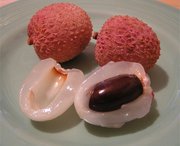Lychee
|
|
| Lychee | ||||||||||||||
|---|---|---|---|---|---|---|---|---|---|---|---|---|---|---|
 Lychee branch with ripe fruit | ||||||||||||||
| Scientific classification | ||||||||||||||
|
The Lychee Litchi chinensis is the sole member of the genus Litchi in the soapberry family Sapindaceae. It is a tropical fruit tree native to southern China, where it is known as 荔枝, in Pinyin lìzhī, south to Indonesia and east to the Philippines, where it is known as Alupag.
It is a medium-sized evergreen tree, reaching 15-20 m tall, with alternate pinnate leaves, each leaf 15-25 cm long, with 2-8 lateral leaflets 5-10 cm long; the terminal leaflet is absent. The newly emerging young leaves are a bright coppery red at first, before turning green as they expand to full size. The flowers are small, greenish-white or yellowish-white, produced in panicles up to 30 cm long.
The fruit is a drupe, 3-4 cm long and 3 cm in diameter. The outside is covered by a red, roughly-textured rind that is inedible but easily removed. The inside consists of a layer of sweet, translucent white flesh, rich in vitamin C, with a texture somewhat similar to that of a grape. The centre contains a single glossy brown nut-like seed, 2 cm long and 1-1.5 cm in diameter. The seed, similar to a buckeye seed, is slightly poisonous and should not be eaten. The fruit matures from July to October, about 100 days after flowering.
There are two subspecies:
- Litchi chinensis subsp. chinensis. China, Indochina. Leaves with 4-8 (rarely 2) leaflets.
- Litchi chinensis subsp. philippinensis (Radlk.) Leenh. Philippines, Indonesia. Leaves with 2-4 (rarely 6) leaflets.
Cultivation and uses
Lychees are extensively grown in their native southern China, and also elsewhere in southeast Asia, India, southern Japan, and more recently in Florida and Hawaii in the United States, and the wetter areas of eastern Australia. They require a warm subtropical to tropical climate that is frost-free or with only very slight winter frosts not below -4°C, and with high summer heat, rainfall, and humidity. Growth is best on well-drained, slightly acidic soils rich in organic matter. A wide range of cultivars is available, with early and late maturing forms suited to warmer and cooler climates respectively. They are also grown as an ornamental tree as well as for their fruit.
Litchi_root.jpg
Lychees are commonly sold fresh in Chinese markets (and in recent years, also widely in western supermarkets). The red rind turns dark brown when the fruit is refrigerated, but the taste is not affected. It is also sold canned year-round.
There is a Cantonese saying: "one lychee = three torches of fire". It refers to the extreme Yang property of the fruit. Over-consumption of lychees is reported to lead to dried lips and nosebleeds in some people. By contrast, the related longan fruit is purported to have a nourishing property.
See also
External links
- Fruits of Warm Climates: Lychee (http://www.hort.purdue.edu/newcrop/morton/lychee.html)
- California Rare Fruit Growers: Lychee Fruit Facts (http://www.crfg.org/pubs/ff/lychee.html)
- Know and Enjoy Tropical Fruit: Lychee, Rambutan & Longan (http://www.proscitech.com.au/trop/l.htm)
- Litchi chinensis (Sapindaceae) (http://www.montosogardens.com/litchi_chinensis.htm)de:Litchibaum

